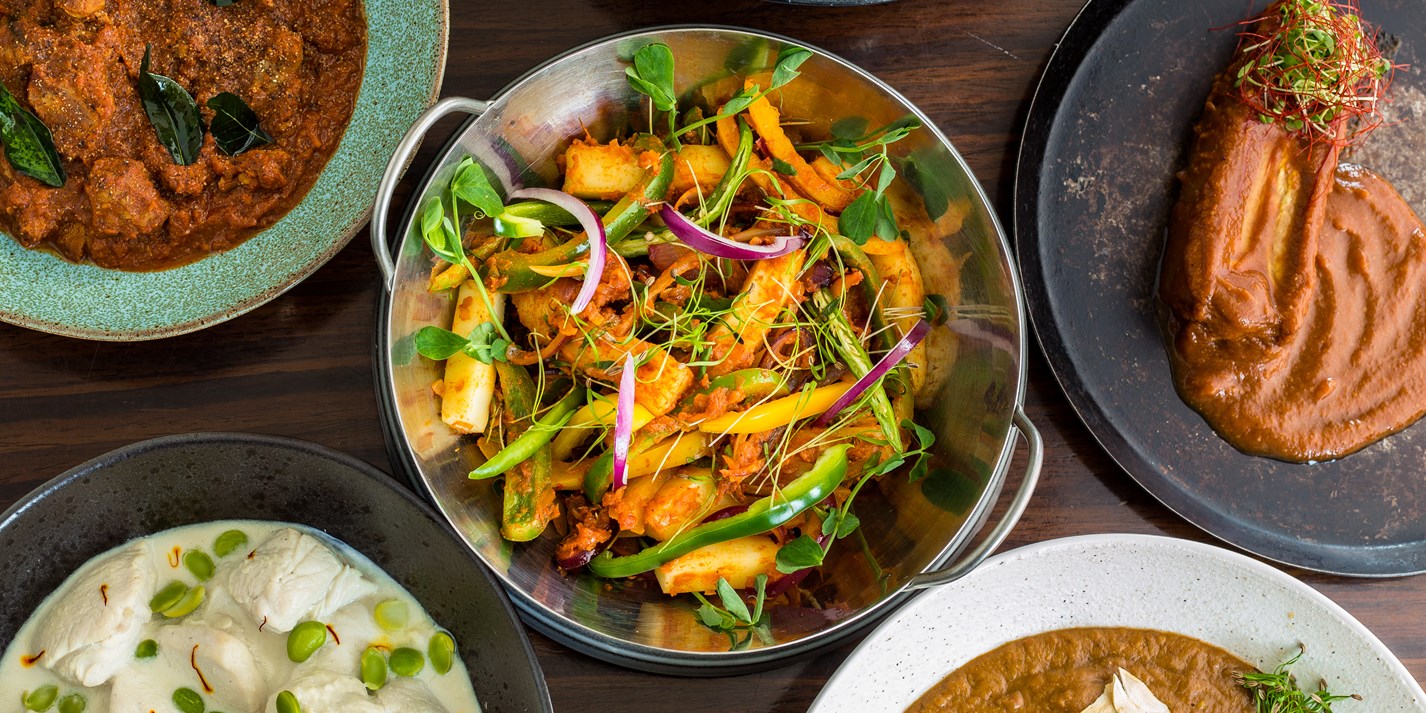
National Curry Week, NOV 2017 Great British Chef’s
Indian food has always been incredibly popular in the UK. Restaurants and takeaways offering ‘Indian’ curries line our high streets, and we’re all guilty of over-ordering whether we’re eating out or getting it delivered. But it’s only relatively recently that we’ve realised the food offered in the majority of these restaurants is almost unheard of in India itself. Many of our favourite Indian dishes were in fact invented or adapted right here in the UK, by chefs looking to create something that would appeal to local tastes.
However, while chicken tikka masala or lamb madras might not be authentic, that doesn’t mean they’re not delicious – when done right. That’s why we asked legendary Indian chef Alfred Prasad to recreate some of the most popular Indian dishes found in British takeaways, and to help explain their origins. Next time you feel the need for a feast from your local takeaway, try making one of these recipes instead – it’ll certainly be healthier and, seeing as it’s from the mind of Alfred Prasad, will taste a whole lot better, too.
‘The many thousand Indian restaurants that dot the British foodscape are mostly (over 90%) owned by Bangladeshi entrepreneurs. Over the decades, they have tried to understand Indian cooking whilst appealing to a local clientele, creating a unique cuisine of their own. In a way, these curries are as much (or more) British as they are Indian.
‘Supermarkets love using the word ‘authentic’ to describe their Indian ready meals. Across the board, we come across terms such as ‘Authentic Madras Curry’, ‘Authentic Rogan Josh’ or ‘Authentic Dhansak’ – they probably mean authentic ‘British-Indian Curry’. Today the UK is better educated about regional and micro-regional cuisines and also about what’s ‘authentic’ and what’s not. For example, an authentic Kashmiri Rogan Josh does not contain onions or tomatoes; an authentic Vindaloo is only ever made with pork; a single, authentic Madras curry simply does not exist and an authentic Dhansak is a far more complex dish than our curry house versions.’
The dishes
Dhansak
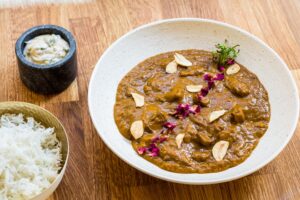
Lamb Dhansak by Alfred Prasad
‘A Parsi classic, this curry combines lentils, vegetables and lamb. Traditionally the lentils (four types) and vegetables are cooked together, with the lamb curry cooked separately and then added afterwards. It is typically served with a caramelised onion pulao (or pilaf) and kachumber salad (a dish of fresh chopped tomatoes, cucumbers, onions and chilli). In the UK, the recipe has transformed into something much quicker, with lentils and lamb cooked together and using fewer ingredients.’
Vindaloo
‘Key milestones in India’s culinary journey include the origin of Ayurveda, our ancient food science and the arrival of Babur, the first Mughal emperor, who brought Middle Eastern and Mughal food to India. Another important landmark was the coming of the Portuguese to India, significant for a few reasons – they brought the chilli and tomato, were an important carrier in the Silk Route (trading spices) and also enticed other Europeans to approach Indian shores.
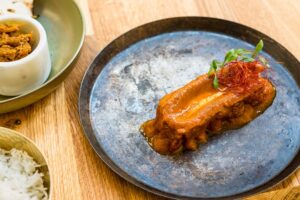
Pork Belly Vindaloo by Alfred Prasad
To me, Vindaloo is a thriving confluence of Portuguese, Indian and British food cultures. The word literally means vino (wine or, in this case, vinegar) and d’alhos (garlic). The dried red chillies, soaked and ground with vinegar, gives it a quintessential flavour. A lot of people incorrectly think it is a dish containing potato as it ends with ‘aloo’ (as in Saag aloo). Anglo-Indians do enjoy potatoes in most forms of meat curries, so you would see them quite often in a Vindaloo, but in India it is associated with Goa (where the Portuguese legacy is still palpable today) and is almost always made with pork. In the UK, Vindaloo sits close to the top of the unique heat scale of British curries. Even the song ‘Vindaloo’ by Fat Les became England’s unofficial anthem at the France ’98 FIFA world cup, a symbol of multiculturalism and how mainstream Indian food had become in Britain.’
Madras
‘During my early days in London, I remember being fascinated that there was such a thing as a Madras curry. It does not exist in Madras or any other part of India for that matter!
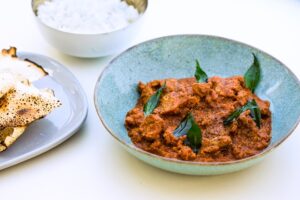
Duck Madras by Alfred Prasad
I have used flavours and spices that I associate with Madras or Tamil Nadu: black peppercorns, dried red chillies, Kalpasi (a lichen), curry leaves and tamarind. It’s certainly much better than using an off the shelf Madras sauce or paste and allows the flexibility of using more or less of the flavourings you may like or dislike. Here in the UK, Madras is also near the top of the heat-scale with the inclusion of ‘Madras curry powder’ – a spice blend containing curry leaves, pepper and turmeric, among other spices.’
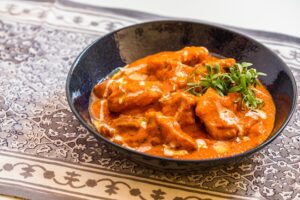
Chicken Tikka Masala by Alfred Prasad
Chicken tikka masala
‘An adaptation of the wonderful Murgh Makhani, this dish has ruled British hearts for the longest time. It is considered Britain’s national dish and is easily the most popular item on a curry house menu. It is also an urban legend, with several people claiming they created it.’
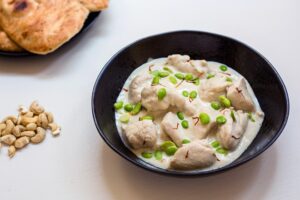
Chicken Korma by Alfred Prasad
Korma
‘I fully understand the British love for this creamy and mild curry, an easy initiation into a new cuisine. A refined curry noted for its silken texture thanks to almonds or cashew nuts (or both) and the fragrant notes of cardamom. Most curry houses in the UK substitute the nut paste with coconut, which is cheaper but also works in its own way.’
Paneer Jalfrezi by Alfred Prasad
Jalfrezi
‘From the Bengali word meaning ‘hot’ and ‘fried’ (as in stir-fried), the high temperature, rapid method of cooking makes Jalfrezi distinct from other ‘curries’. A 2011 poll naming it Britain’s favourite curry (replacing the tikka masala) is quite an extraordinary story. If there ever was to be such a poll in India, I very much doubt Jalfrezi would make it into the top ten.’
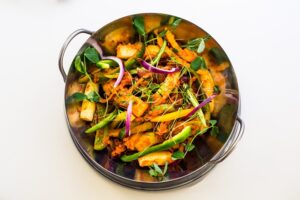
Paneer Jalfrezi by Alfred Prasad

